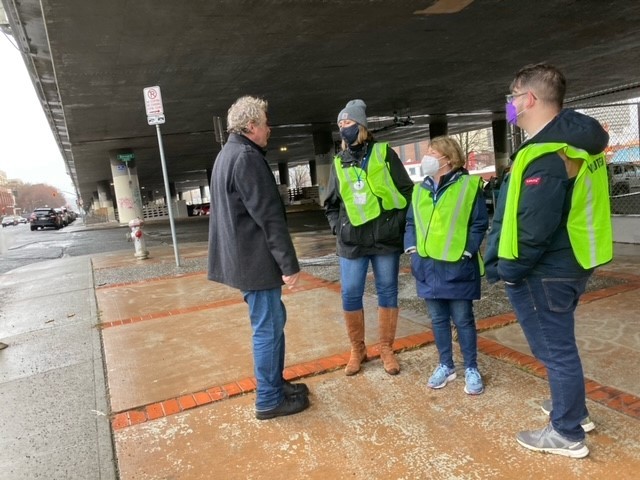An Eastern researcher and his students participate in Spokane’s Point-in-Time Count.
For individuals and families who lack a permanent place to call home — and those trying to help them —the journey to stable housing is often long and arduous. Even understanding the scale and scope of the problem is a challenge.
Spokane’s annual Point-in-Time (PIT) Count, a county-wide census of persons without housing, aims to bring the issue into better focus. The annual count, a federally mandated and funded effort conducted at the end of February, brings volunteer data-collectors into the city’s streets and shelters to pose questions central to the homelessness issue: How many are lacking housing, and why? Who are those in most need? What barriers they are facing, and how might the city and county more successfully assist them?

This year’s count, organized by the city’s Community, Housing and Human Services (CHHS) Department, included a significant boost from Eastern faculty and student volunteers, including contributions from EWU’s Matthew Anderson, an associate professor of urban and regional planning who was recently awarded EWU’s prestigious Jeffers W. Chertok Memorial Endowed Professorship.
Anderson, whose research background includes work in environmental justice, sustainability and city-planning theory, says the Chertok Professorship allowed him to fund three graduate students to help with the effort – Anna Stahl, Graham Zickefoose and Damalie Ndamira.
“This is a rare opportunity for not only these two students, but myself as well, to gain invaluable professional experience, because the project integrates service, community engagement and research into the same activity,” Anderson explains.
EWU Alumnus Amira Djulovic, Spokane’s PIT count coordinator, says “the partnership with EWU is a shining example of how teamwork makes the dream work. About 140 volunteers have signed up for this year’s count, which is phenomenal considering the pandemic, and shows the heart of our community for our homeless individuals.”
Zickafoose is grateful for this opportunity, saying, “This project has been an exciting and unique opportunity for me to learn about a crucial process that happens in cities across the country every year.”
In addition to tabulating numbers, Eastern students also collected broader survey data — information they hope may help dispel common misconceptions about the local homeless population. Among these myths, says Anderson, is the belief that most of the city’s unhoused are from elsewhere. In fact, he says, a solid majority are from right here in Spokane.
And while it’s true some are homeless chiefly because of drug and alcohol dependencies, he adds, “there’s just as many who aren’t addicted to drugs – and they don’t want to be around it either.”

In reality, Anderson continues, poor decision making is seldom the sole cause of homelessness. Instead, the growth of unsheltered individuals and families is directly correlated to a lack of both affordable housing, robust tenants’ rights laws and reduced government funding.
“All it takes to become homeless is an eviction or losing your job. Any number of things can happen — medical problems, [lack of] healthcare coverage, a bill they couldn’t pay. All it takes is getting evicted,” he says.
According to the city of Spokane, the count will help maximize what resources are available by helping officials “develop and refine strategies to move people into permanent housing,” wrote Brian Walker, a communications manager, in a recent press release.
For their part, Stahl, Zickefoose and Ndamira, each of whom are both working on degrees in urban and regional planning, were focused on the logistics of actually collecting those data. They got a jump-start on their contributions during a Jan. 6 “practice run” held at a makeshift downtown facility for the unsheltered.
Because early January was bitterly cold, the city had opened a temporary warming station at the Spokane Convention Center. Many of the 300-400 persons gathered there had previously been encamped outside City Hall, part of a protest calling for improved services and more shelter space.
Stahl, Zickefoose, Ndamira, along with Anderson, visited the warming station, survey questions in hand, determined to get a read on why the protestors and others felt the current system was inadequate.
Many of those interviewed told the Eastern researchers they avoided shelters because they didn’t feel respected by shelter staff. Others pointed to safety concerns. Anderson says their complaints have merit. “A lot of people feel safer on the streets with their immediate network of people.”
“I’m excited about this project because it’s very hands-on and involved in an area that is a huge need for Spokane,” says Stahl.
“Our information gathering also illuminated the fact that there are way more people out there than the existing shelter space can accommodate,” continued Anderson, adding that he hopes the information collected that day will encourage area decision-makers to continue actively working to find additional locations for permanent shelters.


